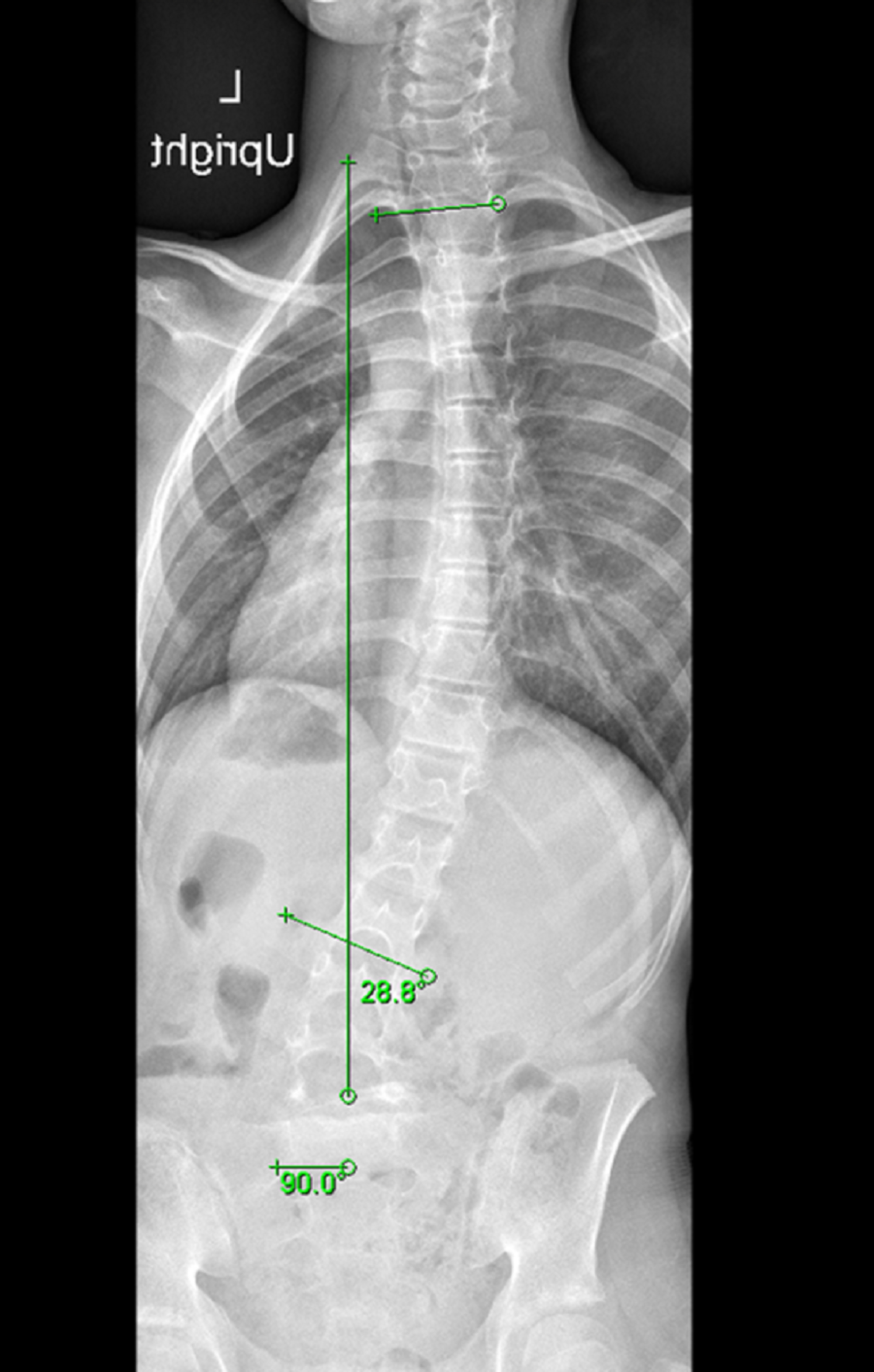Scoliosis Military Discharge - The elderly spinal deformity includes patients with spinal deformity (scoliosis) of varying degrees or affected by degenerative disc and joint disease. The adult scoliosis can be the result of constant or changing youth or a new, de novo, the beginning of deformity caused by degeneration or aging of the spine. Degenerative scoliosis accounts for the majority of scoliosis cases in adults aged 65 years and older, as seen in the lower proportion of elderly patients with a diagnosis of primary idiopathic scoliosis.
Degenerative scoliosis is one of the most difficult forms of the spine to treat because of the changing nature of the condition. Usually, it is thought that it starts with degeneration of the intervertebral discs, which causes a misalignment of the vertebral column. Degenerative scoliosis, especially in the elderly, is often associated with other conditions, such as osteoporosis. Clinical outcomes for nonsurgical and surgical procedures are not well documented; Therefore, recognition and early intervention are important to avoid the complications of scoliosis in adults. The role played by undiagnosed adolescent idiopathic scoliosis in the development of degenerative scoliosis later in life is unknown.
Scoliosis Military Discharge

The clinical presentation and management of adults with scoliosis is characterized by considerable variability. There is a negative relationship between the size of the deformity and the impact of scoliosis on the state of health, because patients with a large spine can have pain and disability and patients with mild relative deformity may experience severe pain. Deformity in the sagittal plane is associated with more disability than scoliosis.1 Patients with scoliosis seek treatment for symptoms, such as back pain, neural symptoms and development of deformity. It is often the neuronal symptoms secondary to spinal cord injury that lead patients to seek medical attention.
No Need For Sternal Fixation In Traumatic Sternovertebral Fractures: Outcomes Of A 10 Year Retrospective Cohort Study
The majority of adult spinal deformity and scoliosis are benign, with an estimated prevalence of 2.5% to 25% of the population.2
7 A 2005 study reported a prevalence of mild to severe adult-onset pain of up to 68% in healthy individuals (without known scoliosis or spina bifida) aged 60 years. or older.8 Many people with degenerative scoliosis go undiagnosed, but older adults often seek medical attention because of back and leg pain that can result from scoliosis and affect the spine.
According to 2010 census estimates, there are 235,205,658 people in the United States over the age of 18. Most of the adult scoliosis mentioned in the literature varies from 2.5% to 60%, depending on the severity. Estimates (2.5%) of the incidence of adult scoliosis result in at least 5.88 million adults in the United States with adult scoliosis. In 2013, approximately 1.28 million of these adults were treated as inpatients and outpatients. (Reference table 2B.2.2 PDF CSV)
Management of adult scoliosis includes non-surgical and surgical methods. Non-surgical treatment of adult scoliosis uses significant resources, and includes interventions such as exercise, physical therapy, injections, medication and manual therapy. However, a non-randomized study in 2010 reported that two years of non-surgical treatment in adults with scoliosis caused significant morbidity and did not improve health outcomes. .10
A Military Man From Florida
Management of scoliosis in adults includes procedures, including decompression alone, decompression with limited fusion, and fusion of deformity. The type of procedure performed is often determined by the main symptoms. Neural symptoms in patients with small curves (<30 degrees) are treated with decompression alone, while patients with large curves and neural symptoms are treated with decompression and fusion. large fusions of more than four levels (five or more vertebrae).12
In 2013, a request from the National Inpatient Survey (NIS) Nationwide Costs and Utilization Project (HCUP) resulted in approximately 142,600 hospitalizations among people aged 18 years and older that were related to diagnosed with scoliosis (ICD -9-CM of 373). Most of these, or 140, 200 patients, were diagnosed as idiopathic scoliosis or scoliosis of unknown origin. Hospitalizations with a scoliosis diagnosis are highest among older adults, with those age 65 and older accounting for nearly half (43%) of all ages. Women account for nearly three quarters (73%) of all scoliosis hospitalizations. Race/ethnicity and region in the United States do not have significant differences. (Reference Table 2B.2.1 PDF CSV, Table 2B.2.2 PDF CSV, Table 2B.2.3 PDF CSV, Table 2B.2.4 PDF CSV)
In 2013, more than half (53.6%) of patients diagnosed with acquired scoliosis/secondary scoliosis had surgery, but only one in five (20.7%) of patients who idiopathic scoliosis has been operated on. The most common procedure in patients with scoliosis is spinal fusion, with 26, 600, or 16%, having this procedure. The majority of scoliosis patients with fusion procedures (83%) had fusion of 4 or more. The patient's gender is not a factor in having the procedure, but people aged 45 to 64 years are more likely to have the procedure. (Reference Table 2B.5.0.1 PDF CSV, Table 2B.5.0.2 PDF CSV, Table 2B.5.1 PDF CSV, Table 2B.5.2 PDF CSV)

The cost of care for adults with scoliosis includes the direct and indirect costs of lost wages, time off work, medical costs and overtime costs. Estimates of the direct costs of nonsurgical care in adults with scoliosis are approximately $14,000 per year.10 The national average cost of hospitalization, including surgical treatment, for patients with the first diagnosis of idiopathic scoliosis was $ 69 400. in 2013 for the average stay in the hospital. do 5,3d. The average cost for people with an infection or a second infection was higher at $120,400 per discharge, with an average stay of 5.9 days. HCUP NIS data does not include hospital costs associated with secondary diagnoses, and does not include physician fees, tests, and other costs associated with hospitalization . Therefore, the best estimate of just the cost of hospitalization for adult scoliosis, both idiopathic and acquired/secondary in 2013 is approximately $11.5 billion ( 166, 600 hospitals). The fees are not necessarily the actual cost. The average cost for patients diagnosed with scoliosis is higher than for all patients discharged from the hospital. (Reference table 2B.3.2 PDF CSV)
Medical Conditions That Can Keep You From Joining The Military
In 2013, slightly more than half (58%) of patients with scoliosis were sent home, while 70% of patients with a diagnosis were discharged regularly. Patients with scoliosis are more likely to be referred to specialists or intermediate care (long-term care) than patients with any other diagnosis. This is especially true for the elderly, with 39% of people age 65 and older with a scoliosis diagnosis moving into a long-term care facility. (Reference table 2B.4.2 PDF CSV)
The true cost of managing adult scoliosis to our health care system is significant, and the cost of care measured by changes in health is not yet fully defined. for non-surgical and surgical care.
Table 2B.3.1: Average Hospital Length of Stay (LOS) and Average Hospital Charges for Discharge with Spinal Curvature Diagnosis, by Sex, United States 2013
Table 2B.3.2: Average Hospital Length of Stay (LOS) and Average Hospital Charges for Discharges with Tuberculosis, by Age, United States 2013
Pdf) Scoliosis, Life Style And Low Back Pain In Adolescents
Table 2B.3.3: Average Hospital Length of Stay (LOS) and Average Hospital Charges for Discharges with Infectious Diseases, by Race/Ethnicity, United States 2013
Table 2B.3.4: Average Hospital Length of Stay (LOS) and Average Hospital Charges for Discharge with Spinal Cord Analysis, by Region, United States 2013
Table 2B.4.1: Dismissal events after hospitalization with scoliosis or sagittal deformity diagnosis, by sex, United States 2013

Table 2B.4.2: Dismissal events after hospitalization with a diagnosis of scoliosis or sagittal deformity, by age, United States 2013
Is This A Mild Scoliosis?
Table 2B.4.3: Dismissal events after hospitalization with scoliosis or sagittal deformity diagnosis, by race/ethnicity, United States 2013
Table 2B.4.4: Dismissal events after hospitalization with scoliosis or sagittal deformity diagnosis, by region, United States 2013
Table 2B.5.0.2: Spinal Fusion for Curvature Spine Diagnosis by Approach, Site, and Number of Levels Involved, United States, 2013
Table 2B.5.1: Hospital procedures leading to spinal cord injury at admission, by sex, United States, 2013
Pdf) Effect Of Intraoperative Autologous Transfusion Techniques On Perioperative Hemoglobin Level In Idiopathic Scoliosis Patients Undergoing Posterior Spinal Fusion: A Prospective Randomized Trial
Table 2B.5.2: Hospital Procedures Performed for Persons with Spinal Cord Diagnosis at Admission, by Age, United States, 2013
Military discharge lawyer, appeal military discharge, military discharge status, military discharge date, scoliosis military, change military discharge, military discharge upgrade lawyer, upgrading a military discharge, military honorable discharge certificate, military discharge review board, military discharge upgrade attorney, military discharge attorney
0 Comments